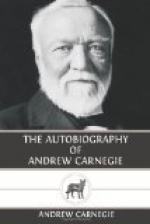Our friends of the Cambria Iron Company at Johnstown, near Pittsburgh—the principal manufacturers of rails in America—decided to erect a Bessemer plant. In England I had seen it demonstrated, at least to my satisfaction, that the process could be made a grand success without undue expenditure of capital or great risk. Mr. William Coleman, who was ever alive to new methods, arrived at the same conclusion. It was agreed we should enter upon the manufacture of steel rails at Pittsburgh. He became a partner and also my dear friend Mr. David McCandless, who had so kindly offered aid to my mother at my father’s death. The latter was not forgotten. Mr. John Scott and Mr. David A. Stewart, and others joined me; Mr. Edgar Thomson and Mr. Thomas A. Scott, president and vice-president of the Pennsylvania Railroad, also became stockholders, anxious to encourage the development of steel. The steel-rail company was organized January 1, 1873.
The question of location was the first to engage our serious attention. I could not reconcile myself to any location that was proposed, and finally went to Pittsburgh to consult with my partners about it. The subject was constantly in my mind and in bed Sunday morning the site suddenly appeared to me. I rose and called to my brother:
“Tom, you and Mr. Coleman are right about the location; right at Braddock’s, between the Pennsylvania, the Baltimore and Ohio, and the river, is the best situation in America; and let’s call the works after our dear friend Edgar Thomson. Let us go over to Mr. Coleman’s and drive out to Braddock’s.”
We did so that day, and the next morning Mr. Coleman was at work trying to secure the property. Mr. McKinney, the owner, had a high idea of the value of his farm. What we had expected to purchase for five or six hundred dollars an acre cost us two thousand. But since then we have been compelled to add to our original purchase at a cost of five thousand dollars per acre.
There, on the very field of Braddock’s defeat, we began the erection of our steel-rail mills. In excavating for the foundations many relics of the battle were found—bayonets, swords, and the like. It was there that the then provost of Dunfermline, Sir Arthur Halkett, and his son were slain. How did they come to be there will very naturally be asked. It must not be forgotten that, in those days, the provosts of the cities of Britain were members of the aristocracy—the great men of the district who condescended to enjoy the honor of the position without performing the duties. No one in trade was considered good enough for the provostship. We have remnants of this aristocratic notion throughout Britain to-day. There is scarcely any life assurance or railway company, or in some cases manufacturing company but must have at its head, to enjoy the honors of the presidency, some titled person totally ignorant of the duties of the position. So it was that Sir Arthur Halkett, as a gentleman, was Provost of Dunfermline, but by calling he followed the profession of arms and was killed on this spot. It was a coincidence that what had been the field of death to two native-born citizens of Dunfermline should be turned into an industrial hive by two others.




